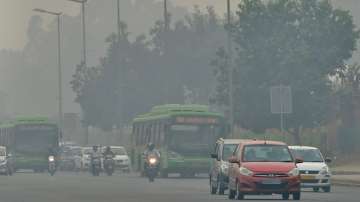Delhi's air quality remained in the 'very poor' category on Sunday but is likely to improve marginally on October 26, government agencies said. The national capital's Air Quality Index (AQI) was recorded at 349 on Sunday.
Some areas like Mundka, Anand Vihar, Jahangirpuri, Vivek Vihar and Bawana recorded 'severe' levels of air pollution in the morning but by evening, Mundka and Vivek Vihar's AQI went into 'very poor' zone, they said.
The Ministry of Earth Sciences' air quality monitor, System of Air Quality and Weather Forecasting and Research (SAFAR), said the AQI is expected to remain in the same range for the next two days but without further deterioration.
"The surface winds are calm during the morning hours but it will pick up during day time, leading to better ventilation. The SAFAR model suggests a marginal improvement in the current condition by tomorrow. AQI is predicted to remain in 'very poor' range for the next two days but without further deterioration," it said.
SAFAR also said stubble fire counts recorded a reduction and stood at 867 on Saturday.
"However, the boundary layer wind direction is north-westerly and wind speed is moderate. This will lead to an increase in pollutant transport towards the Delhi region and hence the SAFAR model estimate of stubble burning share in PM2.5 is 19 per cent today," it said.
While the expected slight increase in local surface wind speed is a positive sign, the stubble transport level wind direction and speed is an unfavourable sign and likely to counter each other, it said.
SAFAR synergized stubble fire counts stood at 1,292 on Friday and its share in Delhi's pollution was nine per cent.
The AQI on Saturday was recorded 346, on Friday it was 366 while it was 302 on the previous day.
An AQI between 0 and 50 is considered 'good', 51 and 100 'satisfactory', 101 and 200 'moderate', 201 and 300 'poor', 301 and 400 'very poor', and 401 and 500 'severe'.
Ten monitoring stations in Delhi entered the 'severe' zone on Friday according to the AQI monitoring mobile application SAMEER, developed by the Central Pollution Control Board (CPCB).
PM 2.5 are tiny particulate matter less than 2.5 microns in diameter and can enter deep into the lungs and even the bloodstream.
The figures are based on data collected from 36 monitoring stations in the city.
The Delhi government has kick-started its 'Red Light On, Gaadi Off' anti-pollution campaign for which it has deployed 2,500 environment marshals at 100 traffic signals across the city to generate awareness and curb vehicular pollution.
The drive will be implemented in all 70 assembly constituencies from October 26 and will go on till November 15 from 8 am to 8 pm.
It is an awareness drive by the Delhi government and no person will be issued challans, the government has said.
Latest India News

